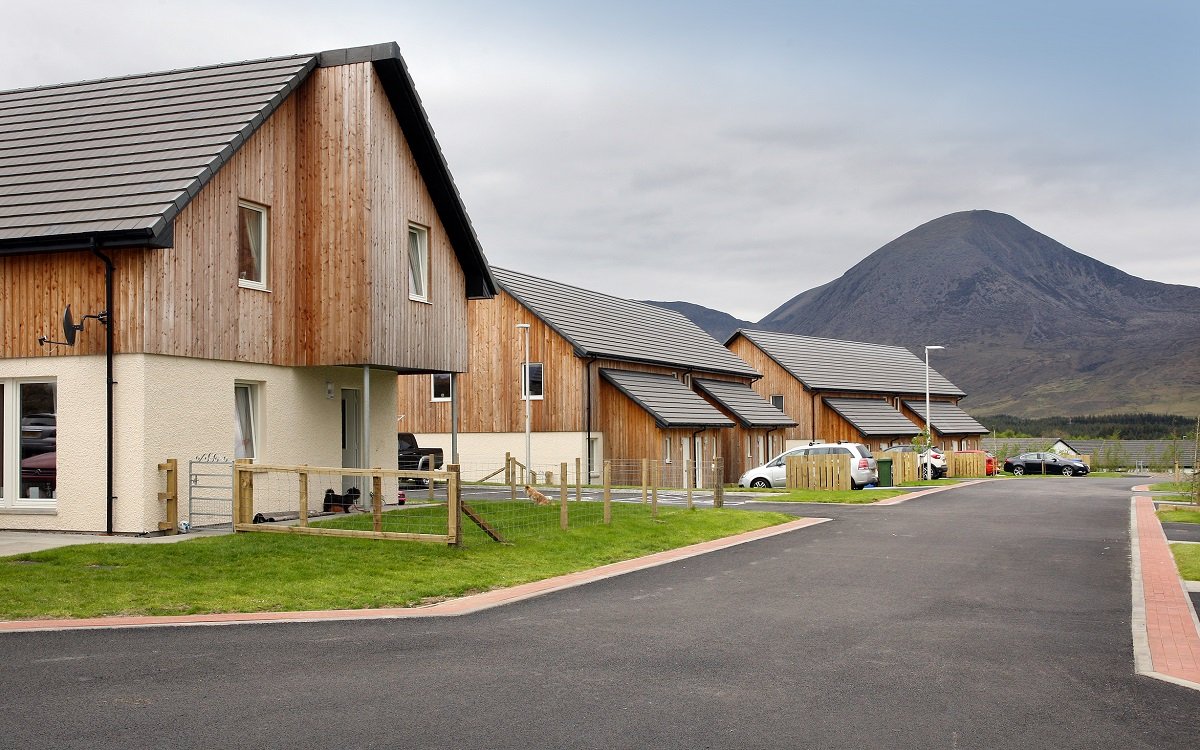Zero direct emissions heat in new build affordable homes: Broadford, Isle of Skye
Lochalsh and Skye Housing Association (LSHA) has been operating across Skye and Lochalsh since 1978. It has c.40 staff, including a large technical services and inhouse maintenance team. LSHA has been installing heat pumps since 2008 and has experience with ground source and biomass shared heating systems. Air Source Heat Pumps (ASHPs) were selected for this development to cost-effectively comply with energy requirements and to follow the Firm Foundations design brief widely used in the Highlands.
Heating system installation
The ASHPs were specified and installed by the heating subcontractor at an estimated cost of c. £11,000 per unit. The models installed were the preferred choice of LSHA as it felt they had a good track record, and it prefers that its own maintenance staff gain in-depth knowledge of a single system. Only one issue arose during installation, as the contractor had installed wired zone thermostats to save capital, but LSHA required these to be replaced with wireless units, so that these could be movable in order to give tenants more control over internal temperatures. This was resolved swiftly in time for the scheduled handover day.
Handover process
Before tenants moved in LSHA energy advisors checked the heating system was set up correctly. Physical and email copies of welcome guides instructed tenants how to operate their system. Tenants were invited to arrange an in person instruction from LSHA energy advisors. This was not offered on handover day as LSHA feel there is too much happening for advice to be taken in effectively on this day.
Tenant impacts
Initial concerns came from tenants who were not familiar with ASHPs. These required home visits to explain that radiator temperatures were designed to be low (and that the heating system is working if they don’t feel ‘hot’), and that the ASHPs were supposed to work continuously rather than be regularly switched on and off. After these initial visits, there have been very few issues and callouts.
LHSA finds that tenants are often nervous to touch their controllers, which can be a good thing if controls have been set up correctly. Tenant satisfaction has been measured through a stock survey and is very high, with 100% of the tenants reporting that they are warm on a cold winters' day.
Technical performance
The heating systems have performed well, with average Seasonal Coefficients of Performance of 2.54. Additionally, average annual energy bills (heat and electricity) for the development are £250 less than the Scottish average. As such, no issues have been raised around heat costs. In terms of maintenance, LSHA’s inhouse team has performed annual services and there have been no unplanned requirements. Based on the rest of their housing stock (which includes over 270 ASHPs of the same model – with only one ASHP failure), LSHA anticipates that the heat pumps will be replaced after c. 15 years.
Lessons learned
LSHA finds that the heating systems at Suisnish Place work well, are easy and affordable for tenants to run, and offer good zone control.
Better communication with the contractor regarding the exact requirements for system control would have avoided the snagging issue that arose.
Tenants who have not had heat pumps before require support to understand how these systems differ in operation compared to high temperature fossil fuel boiler systems.
Produced by Locogen Ltd and Lochalsh and Skye Housing Association as part of the Evaluation of Heat in Affordable Housing (Phase 2) for the Scottish Government. July 2022
Source: The Scottish Government
